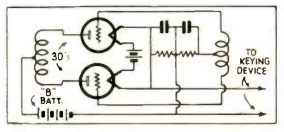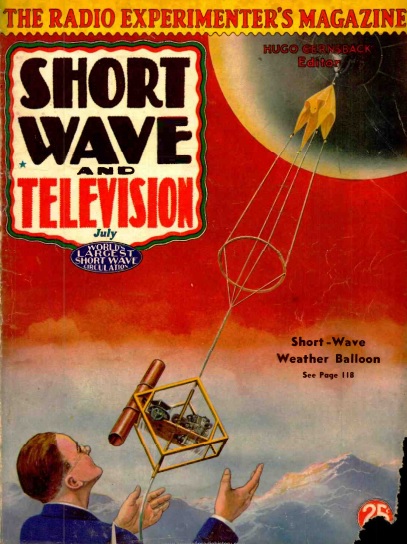Shown here from 80 years ago this month is a weather balloon from the cover of the July 1937 issue of Shortwave and Television magazine.
 The accompanying article explains the operation. The transmitter consisted of two type 30 tubes operating push-pull, as shown in this schematic. The system was developed under the direction of National Bureau of Standards physicist Dr. L.F. Curtiss, who chose the type 30 tube due to their low cost, since there was no guarantee that the set would be recovered, and also due to their low filament drain.
The accompanying article explains the operation. The transmitter consisted of two type 30 tubes operating push-pull, as shown in this schematic. The system was developed under the direction of National Bureau of Standards physicist Dr. L.F. Curtiss, who chose the type 30 tube due to their low cost, since there was no guarantee that the set would be recovered, and also due to their low filament drain.
The 45 volt B battery was specially designed and built by Eveready, and represented the lightest weight B battery ever built.
When the hydrogen balloon was launched, it began transmitting pressure, temperature, and humidity. Keying was done by an electric motor. While the article didn’t provide details, it appears that the length of each signal encoded the data. On the ground, a superregenerative receiver hooked to a strip recorder was used, allowing the duration of each pulse to be measured accurately. A vertical dipole was used for reception of the signals, which were on exactly 55 MHz.
Not surprisingly, the airborne signals could be received over a long distance, despite the low power. The article noted that signals had been received over a hundred miles, and from altitudes as high as 127,000 feet (24 miles). When the balloon reached maximum altitude, it burst, with the transmitter descending on a small parachute. The article noted that the parachute was mostly to prevent damage to persons or objects on the ground, recovery of the transmitter apparently being a secondary concern. Dr. Curtiss noted that it was his hope that the transmitters would soon be made so cheaply that it would no longer be worthwhile to attempt recovery.

